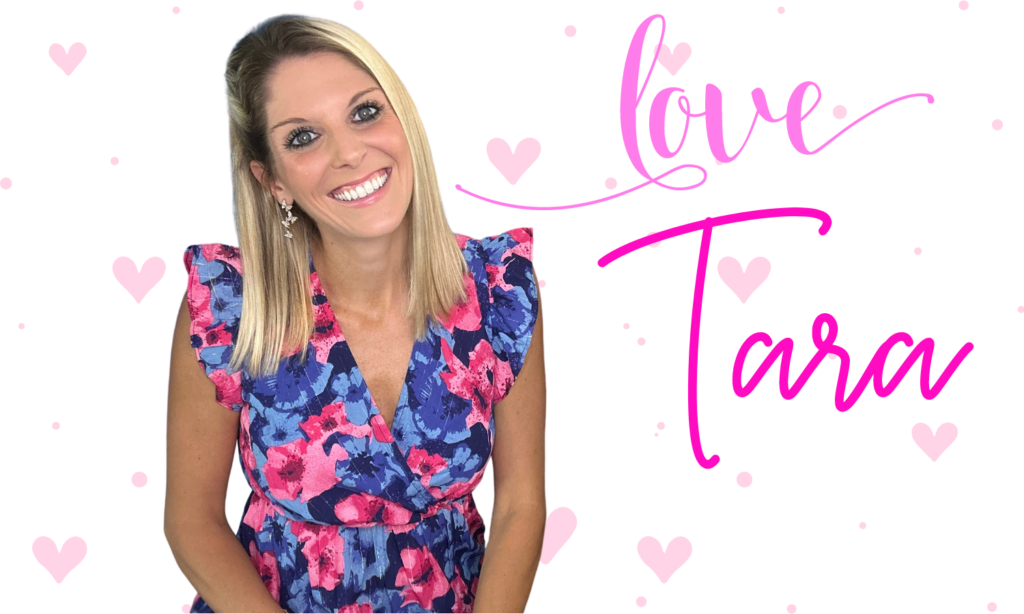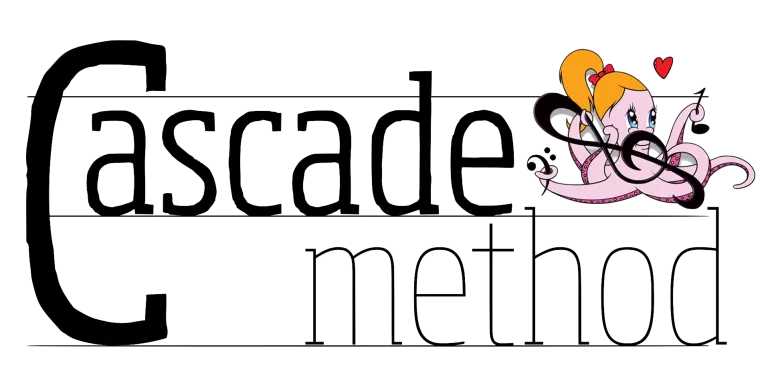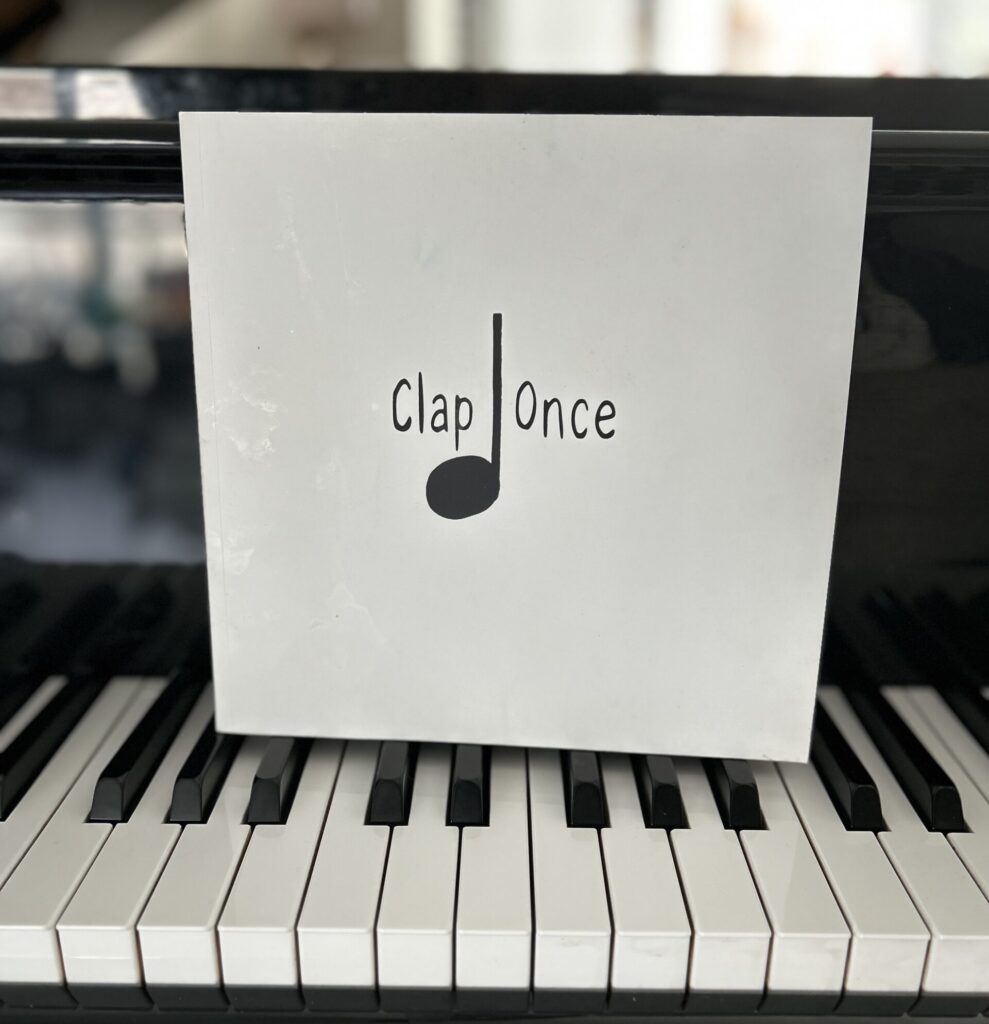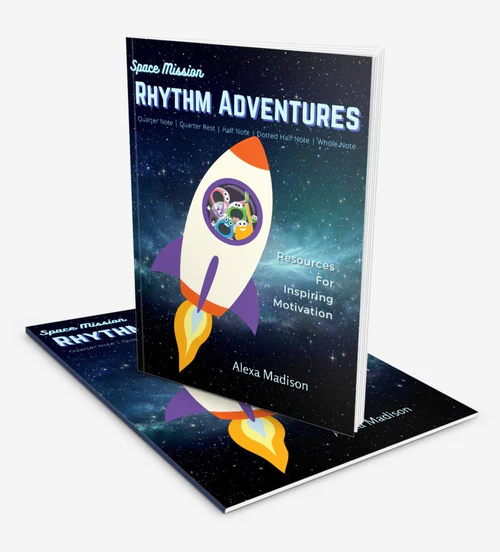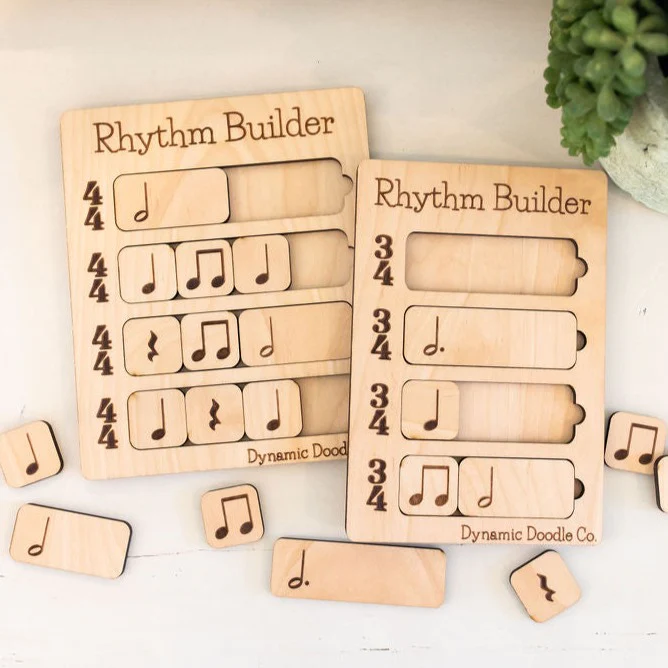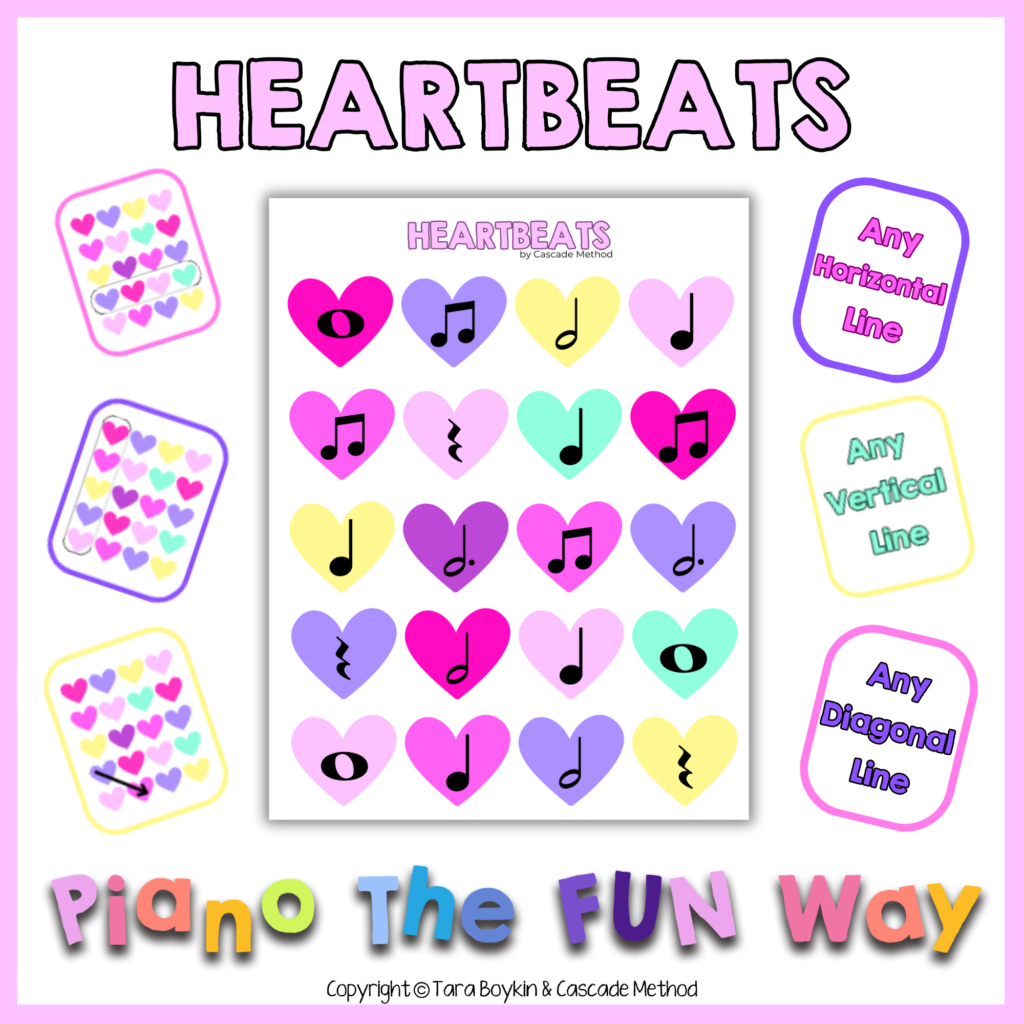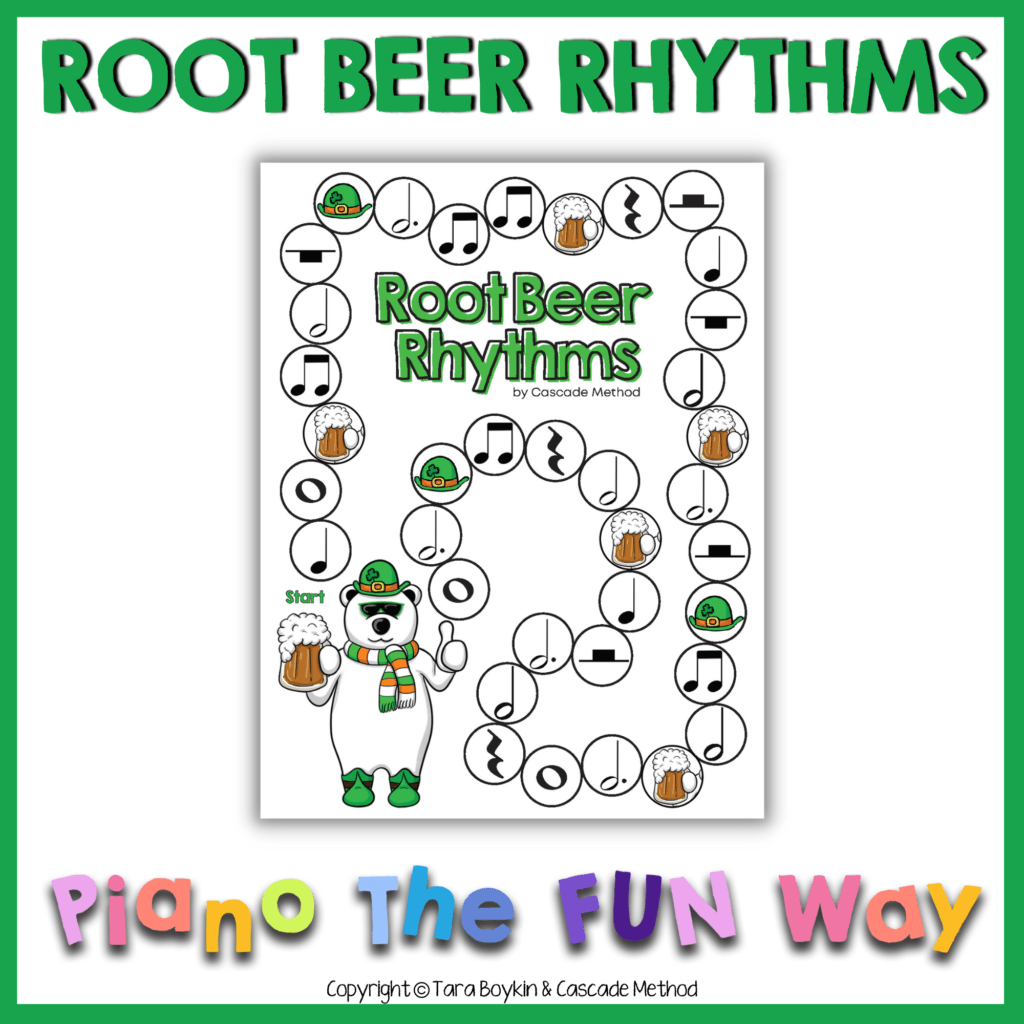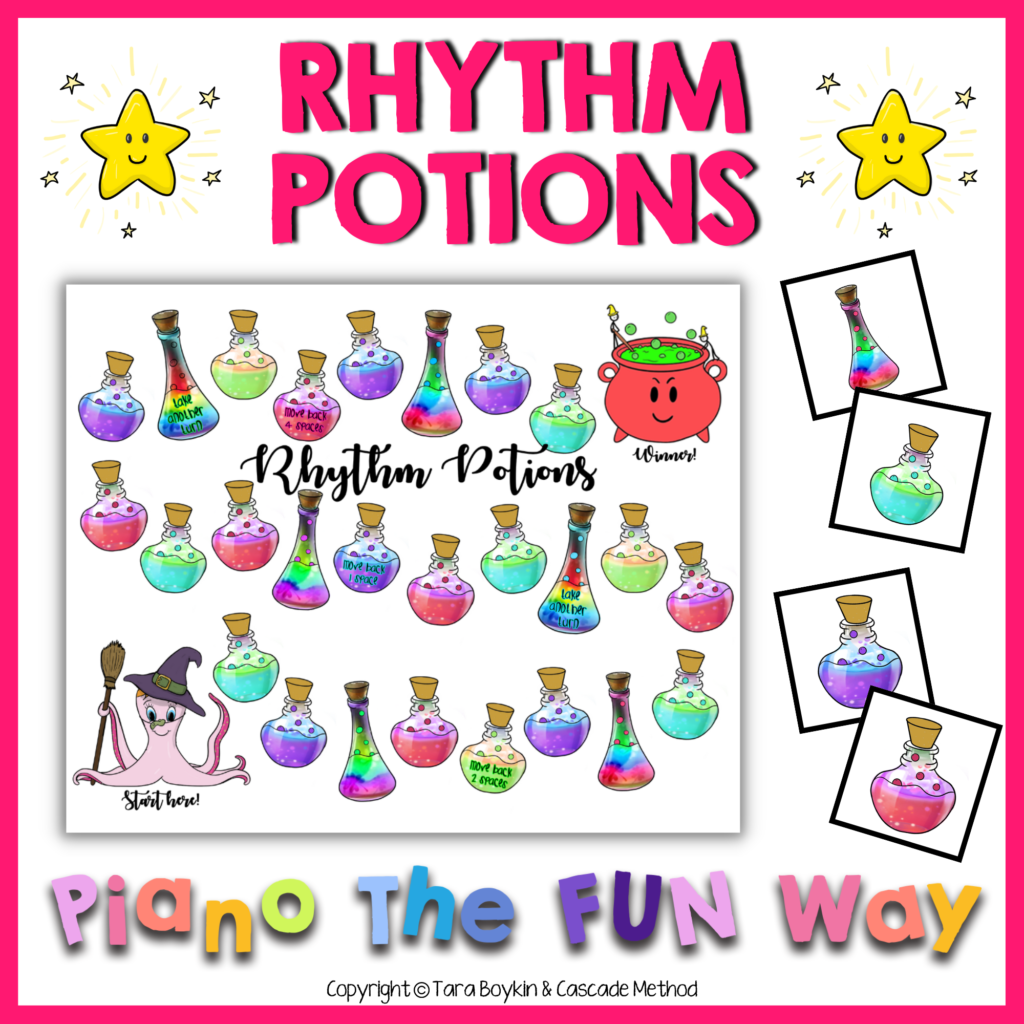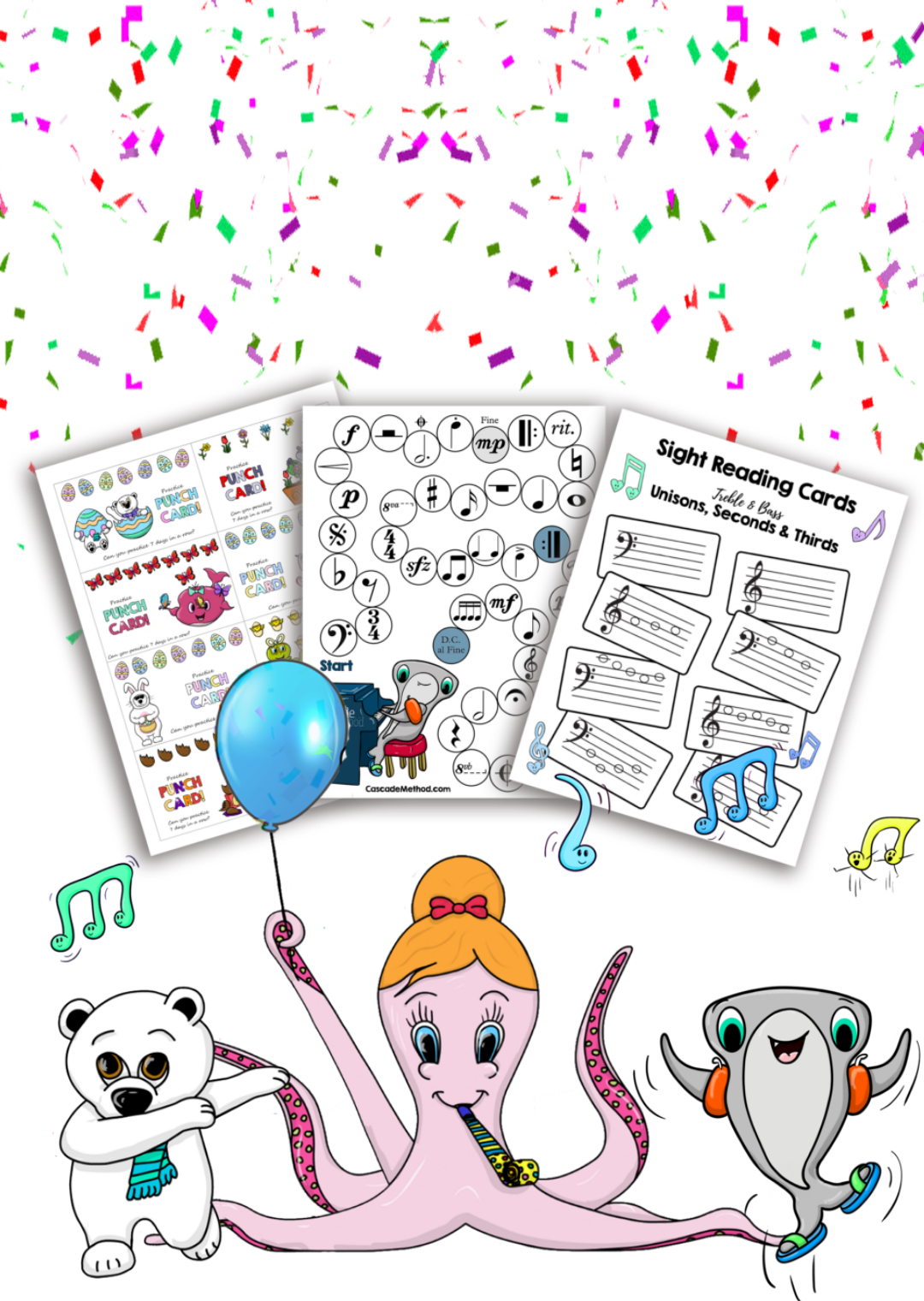
Top 10 Rhythm Resources For Music Lessons – Part 1
I’ll be honest teachers, rhythm was NOT my forte growing up! I remember always asking my teacher to play my pieces before I had to figure them out, and secretly did my best to remember how the rhythm went! 😂
And trust me, this went out for years! I even struggled with the rhythm in the first measure of Beethoven’s Pathetique Sonata! My teacher kept telling me to count it out, but I just didn’t understand those 32nd notes, or dotted s dotted sixteenths!! I just had the hardest time internalizing rhythm, which is one of the reasons I do my best to include them in my lessons so that students don’t struggle the way I did.
Anyway! We’re going back to basics here, where I’ll be sharing my FAVORITE rhythm resources I use in my piano lessons. From picture books, to songbooks, to method books, to manipulatives, printable piano games, and more, part ONE will have you covered for LOADS of rhythm fun! I’ll save all my favorite boom cards and printables from other teachers for the Rhythm Blog PART TWO!
Have you heard of Jodi Fisher? She’s an incredible musician, singer, author, and all around, human being! If you don’t follow her, then you’re missing out!
If there’s one thing I’ve noticed lately, it’s that kids are completely captured by picture books! Jodi’s book, Clap Once, is no different! The second I pull this book out, kids are glued! Clap Once introduces quarter notes, half notes, whole notes, quarter rests, sixteenth notes, and a couple more musical symbols, in the most fun and creative way. The one warning I will give you, is to tell your students to be gentle when they have to “karate chop” certain notes in half… You’ll understand what I mean if you read the book, or watch the video below. However, getting the kids engaged that way is one of the many reasons students love this book so much.
I recommend EVERY teacher have this book in their music library!
If I had to choose ONE app for practicing rhythm, I’d choose Rhythm Swing! It’s adorable, the kids love it, the graphics are so fun, and it’s as close as you get to a video game!
What I love most about it is that students truly internalize tempo while reinforcing note and rest values. That’s because when they go to play a round, the accompanying music that they have to tap the rhythm to can either be slow, medium or fast, forcing students to feel the tempo!
The video below is a great quick demonstration of all the features this app has. Students can practice Basic Notes (as in quarter notes, half notes, whole notes, & dotted half notes), Basic Rests (quarter rest, half rest, whole rest), and eighth notes. Students will also have the option to change the time signature from 2/4, 3/4, to 4/4
One of the reasons why I love this app, is because students have to tap the notes and hold them for the correct amount of time. For example, if there’s a measure with two quarter notes and a half note, they have to tap the quarter notes on the right beat (obviosuly), and then HOLD the half note exactly 2 counts, otherwise it will be considered wrong, and they’ll lose a monkey life! 😂
That’s another reason why students love this app so much, because it gets their competitive side going! They have three chances to “help the monkey swing to the other side without getting eaten by the crocodile!” 😂 This is a great app students can practice at home in between lessons.
Here’s one of my students practicing with the app!
Rhythm Bang
Now that I’ve gotten that amazing story out of the way, I can tell you a little more about this ridiculously fun rhythm method book! However, take it from the author herself:
“Join our rhythms in a thrilling journey to outer space! Students will be challenged to steer the spaceship as they learn their basic rhythms: the quarter note, half note, whole note, and more to make it to Saturn. The method book includes colorful worksheets, games, and challenges for the most exciting adventure.”
I just love how each note is a character (as in, Tom the Quarter note, Henry the Half Note, Dilly the Dotted Half Note, Wally the Whole Note, and Quinn the Quarter Rest).

When a new note is introduced, students will learn a piece to reinforce that new rhythm. Along side of that piece is a teacher duet, that you can find in the TEACHER DUET version of this book!
This book and these characters were just so adorable that I had to create a Rhythm Boom Deck to go along with it! However, more on that deck in Top Rhythm Resources Part Two!
For now, do yourself a favor (or rather, your students), and grab Space Mission: Rhythm Adventures on Amazon!
Using manipulatives is one of my favorites ways to teach! Children and students learn so much better when they have the opportunity to be hands on! That’s why I love using Stephanie’s Rhythm Builder!
Here’s what she has to saw about this Rhythm game: “If you’re looking for unique and educational music teacher resources, our Rhythm Builders are the perfect choice! Made from stunning high-quality birch wood, these music teacher-approved tools are designed to inspire creativity and reinforce rhythm and note-lengths in a fun and interactive way! Featuring durable clear-coated rhythm tiles, these boards are a versatile music teaching tool that you and your students are sure to love.”
I couldn’t agree more! I’ve been using these with my beginner students but if you want some more advanced rhythms, Stephanie has that option as well!
Heartbeats if a great game to pull out during Valentines, but if you love hearts and love like I do, then you can pull .this out year round! Once you download the board, there are tons of little cards that come with it. Depending on what’s circled, or which way the arrows are pointing, students will have to clap or count that line out loud! If you have total beginners, you can also have them place little pawns on the rhythm you call. There’s always ways you can adapt these games for your piano students!
Here are all the ways you can play:
- Shuffle the playing cards and place them face down.
- Student pulls a card and claps out the rhythm they see on the card.
- They may pull a card that circles the hearts to clap out. When they’re circled, they can play in any direction they want (left to right, or right to left).
- Some cards have arrows with a specific direction (so students will clap out the rhythm in that order).
- Some cards just say to play “any vertical, horizontal, or diagonal line.” Just follow the directions of those cards.
- Some cards say “Find and clap hearts in 3/4” (or 4/4). This means students must find hearts that are next to one another, that add up to 3 beats, or 4 beats total.
- For example:
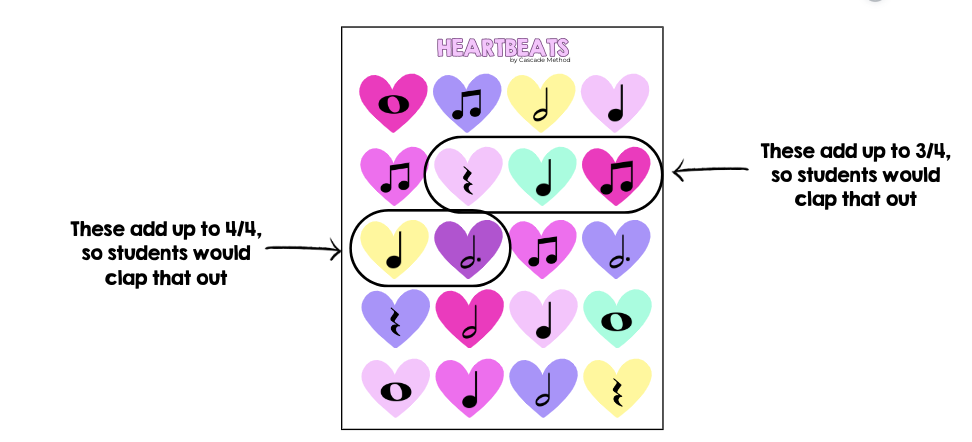
- You decide how long you want to play (from a couple cards, to all the cards).
- If you have competitive students, you can have them keep the cards that they “clap” correctly. Whoever has the most cards by the end, wins.
- For students just learning the names of the types of notes and rests, you can have them place little pawns on the type of rhythm you call. For example, call out a quarter note, and they have to place a pawn on ONE, or all quarter notes. Do the same for the half note, dotted half note, whole note, quarter rest, and eighth notes.
If there’s one game you’re going to want to buy, it’s this one because you won’t be breaking the bank! It’s the best $1 you’ll spend today!
Here’s how to play:
- Place pawns on Polar Bear’s Root Beer to start.
- Student rolls the dice and moves pawn to correct spot. If a student lands on:
- A rhythm: they should name it and clap/count it out. (For example: If they land on a half note, they name it and clap and count to 2).
- A hat: student becomes the rhythm leader. They make up and clap out a fun rhythm on the spot and everyone else playing has to repeat it.
- A root beer: student has to clap all the rhythms between the root beer that they’re on, and the previous one on the board. For example, if a student lands on the first root beer on the board, (i.e. the 3rd circle), the student would clap out the quarter note and half note.
- First student to get to the end of the trail (the whole note by Polar Bear’s thumb) wins!
I always pull out Rhythm Potions around Halloween, but there’s no reason you can’t play year round! Also, you may have noticed that my board doesn’t seem very musical… that’s because I am a huge believer in creating multi-use games that are easy to repurpose! Despite this game being called Rhythm Potions, you can actually use it to teach ANY theory concept you want (from finger numbers, intervals, piano keys and more!). I have examples in the descriptions of this game, but for the purpose of this blog, I’ll explain how I use this to teach and reinforce rhythm.
Here’s how to play:
- Place pawns at the bottom of the board, on Olivia the Octopus!
- Pull a card from the card pile. Move forward the corresponding amount. For example, if a student pulls a half note, student moves forward 2. (If you’re playing with the rhythm wheel, spin the wheel and move forward that amount of beats.)
- If a student lands on 8th notes, I explain that it’s “1” space, because both combined form 1 beat.
- If a student lands on a “move back X spaces,” follow the directions!
- First student to reach the cauldron, wins!
What kid doesn’t love a good game of bingo!? So why not turn it into a rhythm bingo game while we’re at it!? With 6 different boards, you could play this game with several students. These bingo boards have all your basic rhythm notes and rests, so this would be a great review of what each rhythm is called!
As a low prep option, this game comes with a rhythm wheel, so you won’t have to cut out all the rhythm cards! All you’ll need to buy, however, is an spinner arrow, which I get on Amazon.
Here’s my last rhythm game for you today! Eggs in a Basket is a favorite among my students, and in other teacher’s studios too! It was actually one of the first games I created! I remember it vividly, because it was before I knew about Canva, and I actually paid for the Basket artwork!
This is such a cute rhythm game to pull out around Easter time. In the directions, I suggest that you create a slit in the laminated basket, so that students can actually “put in the eggs” in the correct basket! If the rhythm shown on the egg is in 3/4, they’ll drop it in the “3/4 basket,” and same for rhythm in 4/4, they’ll drop it in the “4/4 basket.”
As you know, I’m huge on saving time, and if a printable game isn’t possible at the moment, you can always opt to grabbing the boom deck version! I’ll share more about that one in Rhythm Resources Part 2!
I hope these resources are helpful and make their way into your music studio! If you have any I haven’t mentioned, that you believe are worthy of being shared, let us know in the comments below! Otherwise, happy counting!
